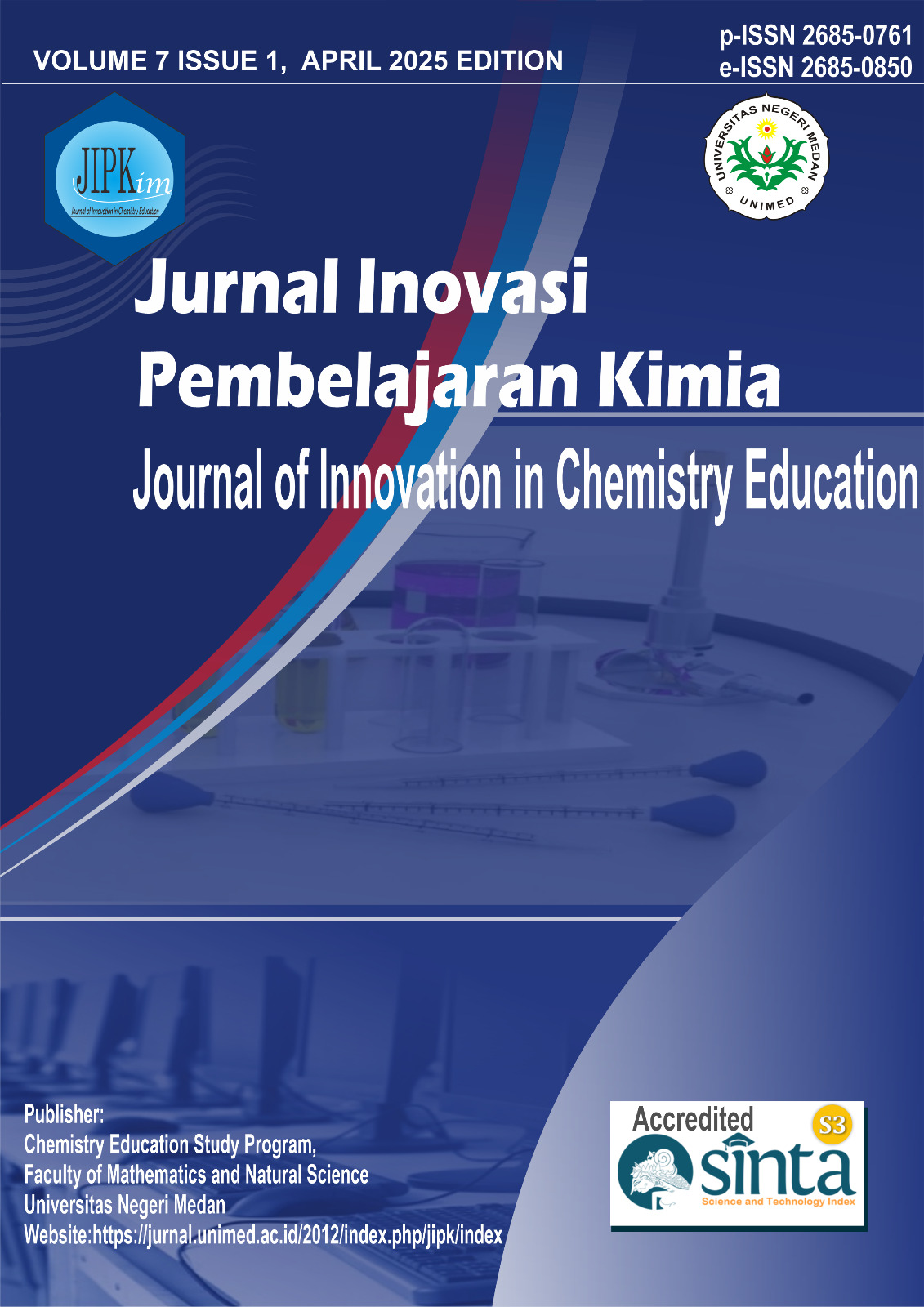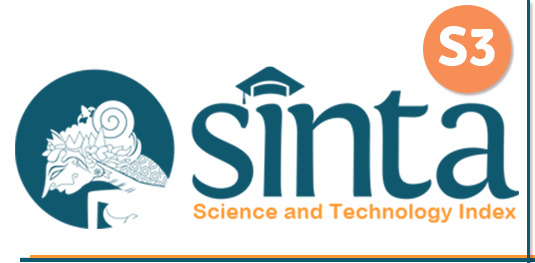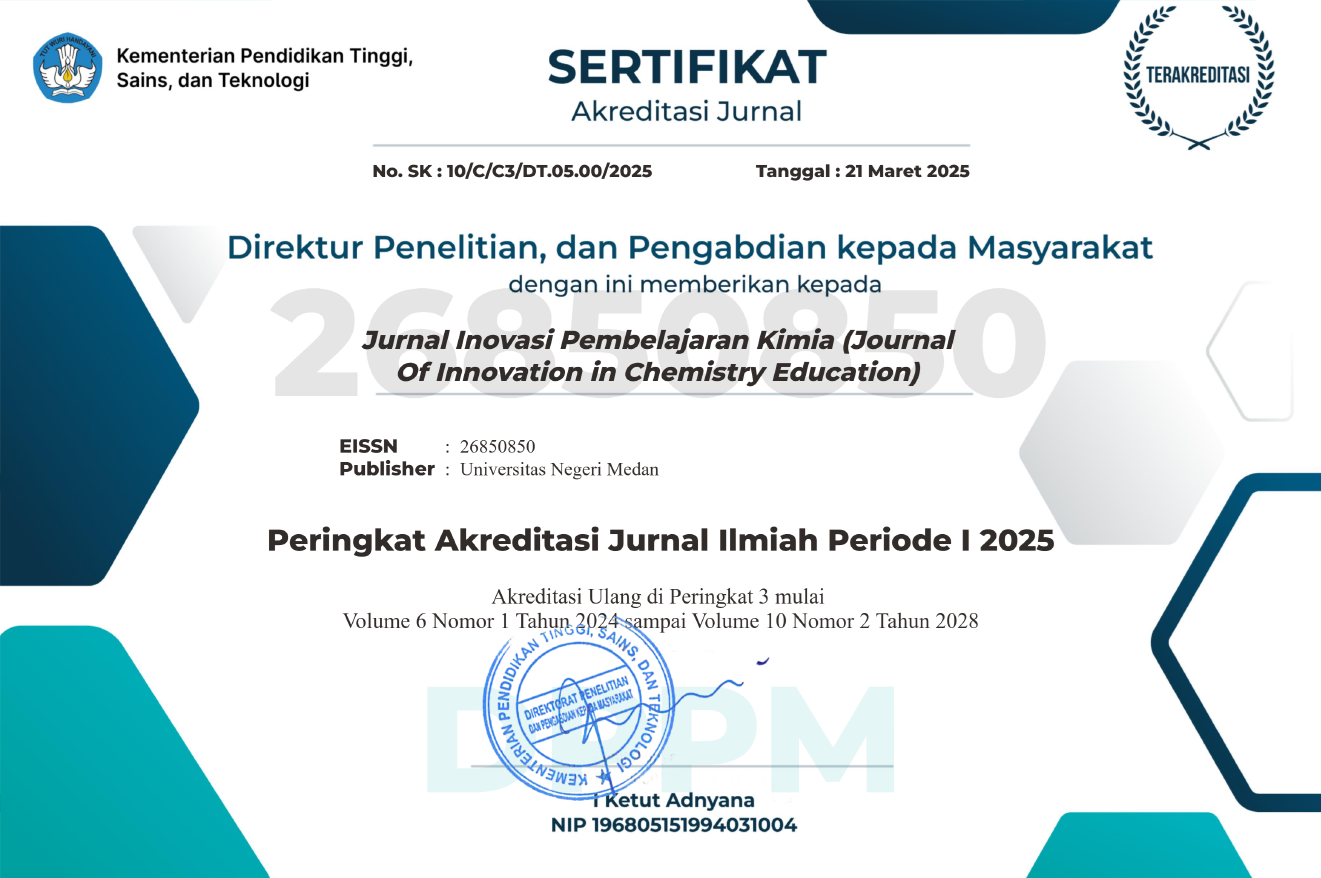A Needs Analysis of Inquiry-Based Virtual Laboratory for Acid–Base Titration
DOI:
https://doi.org/10.24114/jipk.v7i1.67602Keywords:
inquiry-based learning, learning resource, virtual laboratory, acid-base titration, chemistry educationAbstract
Traditional instructional methods, such as PowerPoint and video presentations, often fall short in promoting deep understanding and student engagement, particularly in complex topics like acid–base titration. This study investigates the need for innovative, inquiry-based learning resources integrated with virtual laboratories to support instructional improvement in analytical chemistry. A descriptive qualitative approach was used, involving in-depth interviews with a lecturer and a student, as well as questionnaires completed by 29 students. The findings reveal widespread dissatisfaction with current learning resources due to limitations in interactivity, completeness, and applicability. Most students strongly agreed on the need for enhanced instructional materials, inquiry-driven learning models, and simulation-based tools. A feasibility assessment of existing materials showed high scores in language clarity but highlighted the need for improvements in content quality and visual presentation. These results underscore the importance of combining guided inquiry with virtual laboratories to enhance conceptual understanding, engagement, and critical thinking. The study contributes practical insights for designing more effective learning environments in chemistry education, especially in settings with limited access to physical laboratory facilities.References
Arikunto, S. (2018). Dasar–Dasar Evaluasi Pendidikan Evaluasi Pendidikan. Jakarta.
Aryanti, L., Jalianus, N., & Yulastri, A. (2020). Implementation of Inquiry Based Electrical and Instructional Module in Vocational School. Jurnal Pendidikan Dan Pengajaran, 53(3), 287. https://doi.org/10.23887/jpp.v53i3.25907
Bartosh, D., Kharlamova, M., Pochinok, T., & Stoyanova, E. (2023). Pedagogical Conditions for the Use of Electronic Educational Resources in the Context of the Modernization of Linguistic Education. Studies in Linguistics, Culture and FLT, 11(1), 49–65. https://doi.org/10.46687/WTJO1735
Chen, C., Rabu, S., & Jamiat, N. (2025). Enhancing physics learning achievement, motivation and inquiry skills in a flipped classroom: a structured inquiry-based virtual lab approach. Journal of Baltic Science Education, 24(1), 37–52. https://doi.org/10.33225//jbse/25.24.37
Creswell, J. W., & Creswell, J. D. (2022). Research Design: Qualitative, Quantitative, and Mixed Methods Approaches. SAGE Publications. https://books.google.co.id/books?id=Pr2VEAAAQBAJ
Daeli, Y. F., & Silitonga, P. M. (2024). Utilization of Interactive Media Articulate Storyline In Chemical Bonding Learning For Grade X High School. Jurnal Inovasi Pembelajaran Kimia (Journal of Innovation in Chemistry Education), 5(2), 122–131. https://doi.org/10.24114/jipk.v5i2.54512
Darby, W. T., Wicker, S. A., & Diack, M. (2019). Evaluating the Effectiveness of Virtual Chemistry Laboratory (VCL) in Enhancing Conceptual Understanding: Using VCL as Pre-Laboratory Assignment. Jl of Computers in Mathematics and Science Teaching, 38(1), 31–48. https://doi.org/10.70725/250963jdjtlf
Dezola, R. V., Istiyono, E., & Wilujeng, I. (2023). Student Worksheets Based on STEM Integrated Inquiry Based Learning: Needs Analysis. Jurnal Penelitian Pendidikan IPA, 9(8), 6247–6254. https://doi.org/10.29303/jppipa.v9i8.3062
Erni, E. (2019). The Use of Virtual Laboratory to Improve Students’ Conceptual Understanding in Acid Base Titration Subject. International Journal of Educational Best Practices, 3(1), 43. https://doi.org/10.31258/ijebp.v3n1.p43-49
Faresta, R. A., Safana, M., & Suhardi, R. M. (2023). The Effect of Virtual Lab (VL) Game-Based Guided Inquiry Learning on Students’ Science Literacy in Indonesia. Jurnal Teknologi Pendidikan : Jurnal Penelitian Dan Pengembangan Pembelajaran, 8(4), 822. https://doi.org/10.33394/jtp.v8i4.8926
Fegely, A. G., Hagan, H. N., & Warriner, G. H. (2020). A practitioner framework for blended learning classroom inquiry-based virtual reality lessons. E-Learning and Digital Media, 17(6), 521–540. https://doi.org/10.1177/2042753020926948
Fernandez, M. R. (2020). The importance of teaching titration curves in analytical chemistry. Periodico Tche Quimica, 17(34), 213–219. https://doi.org/10.52571/ptq.v17.n34.2020.230_p34_pgs_213_219.pdf
Feszterová, M. (2022). The education of pre-service chemistry teachers, the content of innovation, methods and forms during COVID-19. R&E-Source. https://doi.org/10.53349/resource.2022.is24.a1104
Hannifa, N., Susanti, D., & Sari, L. Y. (2022). Analysis of Student Needs for Video Media Materials for Cooperative Learning Models in Biology Learning Strategy and Design Courses. Journal Of Biology Education Research (JBER), 3(2), 60–65. https://doi.org/10.55215/jber.v3i2.5948
Harahap, F. Z., Situmorang, M., & Nurfajriani, N. (2022). The Development of Guided Inquiry-Based Learning Resources as a Strategy to Achieve Student Competence in Analytical Chemistry. Proceedings of the 7th Annual International Seminar on Transformative Education and Educational Leadership, AISTEEL 2022, 20 September 2022, Medan, North Sumatera Province, Indonesia. https://doi.org/10.4108/eai.20-9-2022.2324794
Ledya, K., Situmorang, M., & Silaban, R. (2024). Analysis of needs for inquiry-based model development integrated project assignments in high school chemistry teaching. Proceedings of International Conference on Multidiciplinary Research, 6(2), 255–264. https://doi.org/10.32672/picmr.v6i2.1230
Mahaffey, A. L. (2020). Chemistry in a cup of coffee: Adapting an online lab module for teaching specific heat capacity of beverages to health sciences students during the COVID pandemic. Biochemistry and Molecular Biology Education, 48(5), 528–531. https://doi.org/10.1002/bmb.21439
Muis, I., Wonorahardjo, S., & Budiasih, E. (2021). Big Data Support for Problem Solving Method in Mass Spectrometry Topic in Modern Analytical Chemistry Course. International Journal of Interactive Mobile Technologies, 15(9), 167–178.https://doi.org/10.3991/ijim.v15i09.21569
Mulyani, S., Nurdina, R. A., & Mahardiani, L. (2023). Improving Students Learning Outcomes and Digital Literacy on Acid-Base Titration Using Titration Screen Experiment Media. International Journal of Pedagogy and Teacher Education, 7(1), 22. https://doi.org/10.20961/ijpte.v0i0.72051
Nurhayati, N., & Iryani, I. (2022). The effectiveness of the guided inquiry activity with the acid-base titration module on the high school student learning outcomes. Jurnal Pijar Mipa, 17(4), 437–441. https://doi.org/10.29303/jpm.v17i4.3721
Nwigwe, N. (2024). Needs Assessment and Analysis in Learning Material Development for Igbo L2 Learners at the Upper Basic Levels in Ebonyi State. British Journal of Education, 12(3), 16–32. https://doi.org/10.37745/bje.2013/vol12n31632
Pakpahan, D. N., Situmorang, M., Sitorus, M., & Silaban, S. (2022). The Development of Project-Based Innovative Learning Resources for Teaching Organic Analytical Chemistry. Proceedings of the 6th Annual International Seminar on Transformative Education and Educational Leadership (AISTEEL 2021), 591. https://doi.org/10.2991/assehr.k.211110.180
Pardosi, I., & Situmorang, M. (2024). Implementation PhET Virtual Laboratory-Based Learning Media to Increase Learning Outcomes on Teaching of Acid-Base. Jurnal Inovasi Pembelajaran Kimia (Journal of Innovation in Chemistry Education), 6(1), 111–119. https://doi.org/10.24114/jipk.v6i1.57330
Pavitasari, A., Puspita, D., & Sholihah, M. (2025). Pengembangan Virtual Laboratory Pada Materi Inovasi Teknologi Biologi Untuk Meningkatkan Pemahaman Konsep Siswa Kelas X SMA. Jurnal Cakrawala Pendidikan Dan Biologi, 2(1), 151–163. https://doi.org/10.61132/jucapenbi.v2i1.255
Peechapol, C. (2021). Investigating the Effect of Virtual Laboratory Simulation in Chemistry on Learning Achievement, Self-efficacy, and Learning Experience. International Journal of Emerging Technologies in Learning, 16(20), 196–207. https://doi.org/10.3991/ijet.v16i20.23561
Penn, M., & Mavuru, L. (2020). Assessing pre-service teachers’ reception and attitudes towards virtual laboratory experiments in life sciences. Journal of Baltic Science Education, 19(6), 1092–1105. https://doi.org/10.33225/JBSE/20.19.1092
Pierre, D. (2019). Acid-Base Titration. Undergraduate Journal of Mathematical Modeling: One + Two, 10(1). https://doi.org/10.5038/2326-3652.10.1.4913
Priyatni, P., Rusdi, M., & Effendi-Hasibuan, M. H. (2020). Pengembangan Buku Digital Kimia Pada Materi Titrasi Asam Basa Berbasis Inkuiri. Jurnal Pendidikan Kimia Universitas Riau, 5(2), 55. https://doi.org/10.33578/jpk-unri.v5i2.7785
Pulungan, E. N., & Simamora, K. F. (2024). Influence of Canva Media Based on Guided Inquiry Model on Students’ Critical Thinking Ability and Chemical Literacy. Jurnal Inovasi Pembelajaran Kimia (Journal of Innovation in Chemistry Education), 6(1), 100–110.https://doi.org/10.24114/jipk.v6i1.57379
Purba, J., Situmorang, M., & Silaban, R. (2019). The development and implementation of innovative learning resource with guided projects for the teaching of carboxylic acid topic. Indian Journal of Pharmaceutical Education and Research, 53(4), 603–612. https://doi.org/10.5530/ijper.53.4.121
Purba, M. I., Syahputra, R. A., Purba, J., Sutiani, A., & Silitonga, P. M. (2024). Analysis of Students’ Learning Outcomes and Scientific Literacy Activities Using Guided Inquiry and Discovery Learning Models. Jurnal Inovasi Pembelajaran Kimia (Journal of Innovation in Chemistry Education), 5(2), 102–111. https://doi.org/10.24114/jipk.v5i2.55908
Putra, A. J., & Zainul, R. (2024). Designing an Interactive Virtual Laboratory Learning Experience for Acid-Base Indicators. Orbital Jurnal Pendidikan Kimia, 8(2), 166–178. https://doi.org/10.19109/ojpk.v8i2.24630
Rizal, N., & Fitriza, Z. (2021). Deskripsi Keterampilan Komunikasi dan Kolaborasi Siswa SMA pada Pembelajaran Titrasi Asam-Basa dengan Model Inkuiri Terbimbing dan Berbasis Masalah. Edukimia, 3(1), 031–037. https://doi.org/10.24036/ekj.v3.i1.a212
Rizki, R., Hernando, H., Situmorang, M., & Tarigan, S. (2020). The Development of Innovative Learning Material with Project and Multimedia for Redox Titration. Proceedings of the 7th Mathematics, Science, and Computer Science Education International Seminar, MSCEIS 2019. https://doi.org/10.4108/eai.12-10-2019.2296376
Salame, I. I., Montero, A., & Eschweiler, D. (2022). Examining some of the Students’ Challenges and Alternative Conceptions in Learning about Acid-base Titrations. IJCER (International Journal of Chemistry Education Research), 1–10. https://doi.org/10.20885/ijcer.vol6.iss1.art1
Salsabila, M., & Muchlis, M. (2024). The Effect of Self-Regulated Learning Strategy on Student Learning Outcomes in Acid-Base Titration Material. Lectura : Jurnal Pendidikan, 15(2), 380–390. https://doi.org/10.31849/lectura.v15i2.20230
Samosir, R. A., Bukit, J., Situmorang, M., & Simorangkir, M. (2020). Implementation of Innovative Learning Material With Project to Improve Students Performance in The Teaching of Complexometry Titration. Proceedings of the 7th Mathematics, Science, and Computer Science Education International Seminar, MSCEIS 2019, 1, 375–384. https://doi.org/10.4108/eai.12-10-2019.2296541
Sari, A., Yadi, F., & Gulo, F. (2025). Bridging Gaps in Chemistry Instruction: Analyzing the Need for Interactive Learning Media at Senior High School in Sungai Pinang District. AL-ISHLAH: Jurnal Pendidikan, 17(1), 771–783.
Sary, S. P., Tarigan, S., & Situmorang, M. (2018). Development of Innovative Learning Material with Multimedia to Increase Student Achievement and Motivation in Teaching Acid Base Titration. https://doi.org/10.2991/aisteel-18.2018.91
Satriya, M. A., & Atun, S. (2024). The Effect of Argument Driven Inquiry Learning Models on Scientific Argumentation Skills and Higher Order Students on The Topics of Acid Base. Jurnal Penelitian Pendidikan IPA, 10(5), 2663–2673. https://doi.org/10.29303/jppipa.v10i5.6834
Siallagan, E., Sianturi, E. S. D., Harahap, J., & Susanti, N. (2024). Effectiveness Discovery Learning and Learning Cycle 5E Integrated Virtual Lab on Learning Outcomes in Acid-Base. Jurnal Inovasi Pembelajaran Kimia (Journal of Innovation in Chemistry Education), 6(2), 211–219.
Simaremare, S., Situmorang, M., & Tarigan, S. (2018). Innovative Learning Material with Project to Improve Students Achievement on the Teaching of Acid-Base Equilibrium. https://doi.org/10.2991/aisteel-18.2018.93
Sinaga, M. S., Situmorang, M. S., & Hutabarat, W. H. (2019). Implementation of innovative learning material to improve students competence on chemistry. Indian Journal of Pharmaceutical Education and Research, 53(1), 28–41. https://doi.org/10.5530/ijper.53.1.5
Situmorang, M., Sinaga, M., Purba, J., Daulay, S. I., Simorangkir, M., Sitorus, M., & Sudrajat, A. (2018). Implementation of innovative chemistry learning material with guided tasks to improve students’ competence. Journal of Baltic Science Education, 17(4), 535–550. https://doi.org/10.33225/jbse/18.17.535
Situmorang, M., Sitorus, M., Hutabarat, W., & Situmorang, Z. (2015). The Development of Innovative Chemistry Learning Material for Bilingual Senior High School Students in Indonesia. International Education Studies, 8(10). https://doi.org/10.5539/ies.v8n10p72
Sopari, S., Jayadinata, A. K., & Ismail, A. (2024). The Role of PHET-based Virtual Laboratories on Primary Student Motivation and Conceptual Understanding in the Energy Transformation Concepts. Research in Physics Education, 3(1), 8–14. https://doi.org/10.31980/ripe.v3i1.38
Sugiyono. (2014). Metode penelitian bisnis: pendekatan kuantitatif, kualitatif, kombinasi, dan R&D. ALFABETA.
Sypsas, A., Paxinou, E., & Kalles, D. (2020). Reviewing inquiry-based learning approaches in virtual laboratory environment for science education. Διεθνές Συνέδριο Για Την Ανοικτή & Εξ Αποστάσεως Εκπαίδευση, 10(2Α), 74. https://doi.org/10.12681/icodl.2288
Tatsuoka, T., Shigedomi, K., & Koga, N. (2015). Using a Laboratory Inquiry with High School Students to Determine the Reaction Stoichiometry of Neutralization by a Thermochemical Approach. Journal of Chemical Education, 92(9), 1526–1530. https://doi.org/10.1021/ed500947t
Wahyudi, M. N. A., Budiyanto, C. W., Widiastuti, I., Hatta, P., & Bakar, M. S. (2024). Understanding Virtual Laboratories in Engineering Education: A Systematic Literature Review. Ijpte International Journal of Pedagogy and Teacher Education, 7(2), 102. https://doi.org/10.20961/ijpte.v7i2.85271
Wang, Y., Geng, J., & Zhu, Z. (2024). A Comprehensive Teaching Laboratory Program on Titration Analysis: Transition From Classic to Modern Approaches. Journal of Chemical Education, 101(2), 612–620. https://doi.org/10.1021/acs.jchemed.3c01091
West, R. E., Sansom, R., Nielson, J., Wright, G., Turley, R. S., Jensen, J., & Johnson, M. (2021). Ideas for supporting student-centered stem learning through remote labs: a response. Educational Technology Research and Development, 69(1), 263–268. https://doi.org/10.1007/s11423-020-09905-y
Xie, T., Zhang, F., & Wu, E. (2017). Perceived effectiveness of science inquiry in the 3D virtual world. Eurasia Journal of Mathematics, Science and Technology Education, 13(8), 5871–5881. https://doi.org/10.12973/eurasia.2017.01036a













